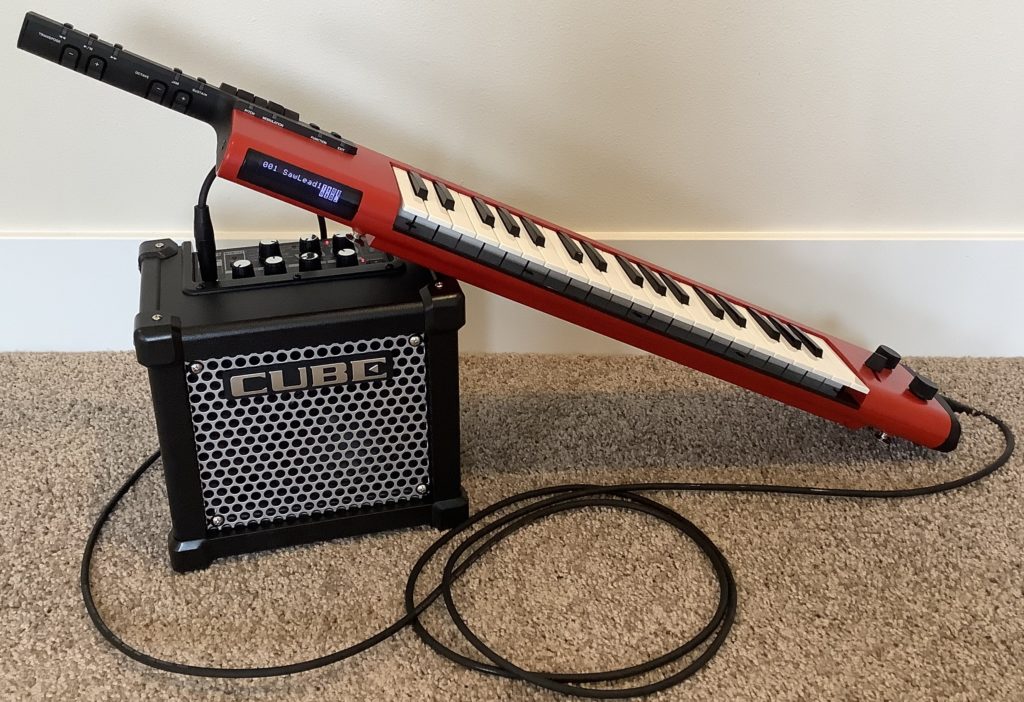You’ll find plenty of rave on-line reviews for the Roland Micro Cube GX — the go-to battery-powered practice amp for guitar.You won’t find a review covering the Micro Cube GX as a portable keyboard practice amp — until now.
Here’s a quick rundown (from the Roland site):
- Compact guitar amp with a 5 inch (12cm) custom-designed speaker
- 3 Watt rated output power
- Eight COSM amp tones, including the ultra-heavy EXTREME amp
- Eight DSP effects, including HEAVY OCTAVE and dedicated DELAY/REVERB with spring emulation
- MEMORY function for saving favorite amp and effects settings
- i-CUBE LINK jack provides audio interfacing with Apple’s iPhone, iPad, and iPod touch
- Free CUBE JAM app for iOS
- Chromatic tuner built in
- Runs on battery power (6xAA) or supplied AC adapter; carrying strap included
- 6 pounds (2.7kg)
I haven’t tried the Roland CUBE JAM application yet, so I’ll be concentrating on the amplifier itself. The included 3.5mm cable is the usual 4 conductor affair although it’s rather short. Roland also includes the AC adapter.
I’ve been searching for a good portable, battery-powered keyboard rig for quite some time. On the keyboard side, the line-up includes Yamaha Reface YC, Yamaha SHS-500 Sonogenic and Korg MicroKorg XL+. Although the YC and Sonogenic have built-in speakers, their sound quality is decidedly inadequate and poor quality. The MicroKorg XL+ doesn’t have built-in speakers. All three keyboards have mini-keys and are battery-powered.
To this point, I’ve been using a JBL Charge 2 Bluetooth speaker.The JBL has solid bass, but its output volume is easily overwhelmed during living room jams. It’s been a good side-kick, but I found myself wanting.

So, the latest addition is the Roland Micro Cube GX. Without comments from fellow keyboard players, buying the GX was a risk. Guitar amps are notoriously voiced for electric (or acoustic) guitar tone. Like the GX, you’ll typically find amp and cabinet simulators that help a guitar player chase their “tone.” The GX, however, includes a “MIC” amp type in addition to the usual 3.5mm stereo AUX input. Fortunately, my intuition was correct and the “MIC” setting does not add too much coloration.
Of course, there is some compromise in sound quality. The amp puts out 3W max through a 5 inch speaker (no coaxial or separate tweeter). Needless to say, you don’t hear much high frequency “air.” The GX cabinet does have a forward-facing bass port, producing acceptable bass even with B-3 organ. No, you will not go full Keith Emerson or Jon Lord with this set-up. 🙂 I first tested the GX with Yamaha MODX and found the B-3 to be acceptable.
Volume-wise, yes, you can get loud — too loud for your bedroom or ear-health. Bass heavy sounds can get buzzy. For clean acoustic instruments, I recommend the “MIC” amp setting. The reverb is pleasant enough and adds depth to my normally dry live patches. The delay is a nice alternative to the reverb ranging from reverb-like echo to explicit (non-tempo synch’ed) repeats.
I find the Sonogenic/Micro Cube GX combination to be the most fun. The SHS-500 has DSP effects, but they are rather tentative, as if Yamaha is afraid to offend anyone. That’s where the GX makes a good companion for the Sonogenic. Feel free to dial in the Jazz Chorus amp with the jazz guitar patch or a British stack with electric guitar. Or, try any of the modulation effects on the Sonogenic’s electric piano. Working with the GX is a far more intuitive and rewarding experience than the built-in Sonogenic DSP effects. You can cover Steely Dan EP to Clapton with this rig!
I have to call out the Heavy Octave and Spring reverb effects. You’ll find them at the right-most position of the modulation (EFX) and delay/reverb knobs, respectively. You can think of them as “going up to eleven.” The spring reverb is decent and you can throw the Heavy Octave onto just about anything to thicken up the sound.
Overall build quality is good. The Micro Cube GX feels solid. A metal grill protects the speaker. The knobs have a pleasant resistance and don’t feel cheap. The only not-so-robust feature is the battery compartment and its cover. As long as you avoid heavy abuse, you should be OK.
For the money, $160USD, it’s a decent sounding, inexpensive package. Given the physical cabinet, output power and speaker size, one should adjust expectations. However, if you’re a keyboardist and need a light, portable, battery-powered amp, the Roland Micro Cube GX is worth a try.
Copyright © 2020 Paul J. Drongowski
